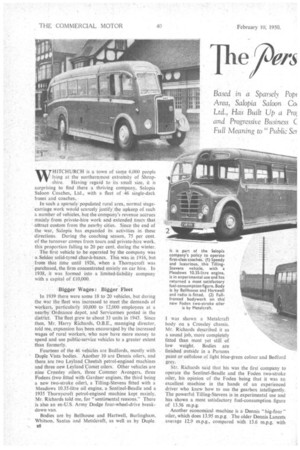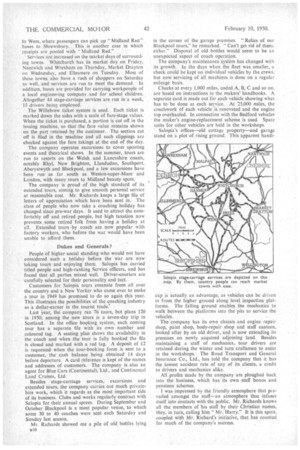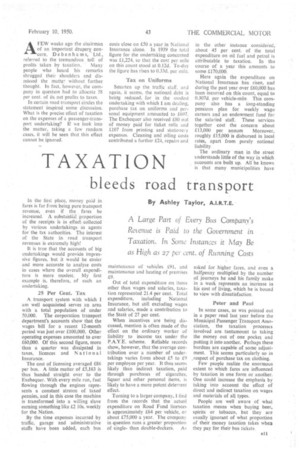eArs
Page 42

Page 43

Page 44

Page 45

If you've noticed an error in this article please click here to report it so we can fix it.
/Touch Creates
WHITCHURCH is a town of some 6,000 people lying at the northernmost extremity of Shropshire. Having regard to its small size, it is surprising to find there a thriving company, Salopia Saloon Coaches, Ltd., with a fleet of 46 single-deck
buses and coaches, .
In such a sparsely populated rural area, normal stage'carriage work would scarcely justify the upkeep. of such a number of vehicles, but the company's revenue accrues mainly from private-hire work and extended tows that ' attract custom from the nearby cities. Since the end of the war, Salopia has expanded its activities in these directions. During the coaching season, 75 per cent. of the turnover comes from tours and private-hire work, this proportion falling to 20 per cent, during the winter.
The first vehicle to be operated by the company was a Selden solid-tyred char-a-bancs. This was in 1916, but , from that time until 1926, when a Thornycroft was purchased, the firm concentrated mainly on car hire. In 1938, it was formed into a limited-liability company with a capital of £10,000.
Bigger Wages : Bigger Fleet In 1939 there were some 18 to 20 vehicles, but during the war the fleet was increased to meet the demands of workers, particularly 10,000 to 12,000 employees at a nearby Ordnance depot, and Servicemen posted in the district. The fleet grew to about 33 units in 1945. Since then, Mr. Harry Richards, 0.B.E., managing director, told me, expansion has been encouraged by the increased wages of rural workers, who now have more money to spend and use public-service vehicles to a greater extent than formerly.
Fourteen of the 46 vehicles are Bedfords, mostly with Duple Vista bodies.. Another 10 are Dennis oilers, and there are two Leyland Cheetah petrol-engined machines and three new Leyland Com-et oilers. Other vehicles are nine Crossley oilers, three Commer Avengers, three Fodens (two fitted with Gardner engines, the third being a new two-stroke oiler), a Tilling-Stevens fitted with a Meadows 10.35-litre oil engine, a Sentinel-Beadle and a 1935 Thornycroft petrol-engined machine kept mainly, Mr. Richards told me, for "sentimental reasons." There is also an ex-U.S. Army Dodge four-wheel-drive breakdown van.
Bodies are by Bellhouse and Hartwell, Burlingham. Whitson. Santus and Metalcraft, as well as by Duple. s8
I was shown a Nletalcraft body on a Crossley chassis.
Mr. Richards described it as a sound job, more completely fitted than most yet still of low weight. Bodies are finished outside in a Parsons paint or cellulose of light blue-green colour and Bedford grey.
Mr. Richards said that his was the first company to operate the Sentinel-Beadle and the Foden two-stroke oiler, his opinion of the Foden being that it was an excellent machine in the hands of an experienced driver who knew how to use the gearbox intelligently. The powerful Tilling-Stevens is in experimental use and has shown a most satisfactory fuel-consumptionfigure of 13.56 m.p.g.
Another economical machine is a' Dennis "big-four" oiler, which does 13.95 m.p.g. The older Dennis Lancets average 12.9 m.p.g., compared with 13.6 m.p.g. with the newer machines. The Sentinel-Beadle and the Foden two-stroke vehicles return consumption figures of 12.83 m.p.g. and 12.6-13 m.p.g. respectively.
The fuel figures depend largely upon the type of work. Bedfords on private hire average 12.48 m.p.g., but those on stage-carriage services return 11.8 m.p.g. Respective results for the Crossley are 12.5 m.p.g. and 11.6-12. These figures are averages over long periods.
The heaviest use of fuel occurs with coaches making trips to Blackpool during the illuminations period from September 15 to October 23. Traffic converges on the• sea front from miles around and 'progress is possible only in bottom gear. It often takes 31 hours to run the five-mile stretch of Blackpool promenade, The amount of fuel consumed by all vehicles totals about 75,000 gallons a year.
An accompanying map shows the routes covered by the 10 vehicles employed on stage-carriage work, Eight direct runs a day are made on the service to Shrewsbury, on which the receipts are shared with the Birmingham and Midland Omnibus Co., Ltd There is also a service
to Wem, where passengers can pick up "Midland Red" buses to Shrewsbury. This is another case in which receipts are pooled with "Midland Red."
Services are increased on the market days of surrounding towns. Whitchurch has its market day on Friday. Nantwich and Wrexham on Thursday, Market Drayton on Wednesday, and Ellesmere on Tuesday. Most of these towns also have a rush of shoppers on Saturday as well, and services are run to meet the demand. In addition, buses are provided for carrying workpeople of a local engineering company and for school children. Altogether 44 stage-carriage services are run in a week, 13 drivers being employed.
The Willehrew ticket system is used. Each ticket is marked down the sides with a scale of fare-stage values. When the ticket is purchased, a portion is cut off in the issuing machine, so that the fare value remains shown on the part retained by the customer. The section cut off is filed in the machine and all such clippings are checked against the fare takings at the end of the day.
The company operates excursions to cover sporting events and theatrical shows. In the summer, tours are run to resorts on the Welsh and Lancashire coasts, notably Rhyl, New Brighton, Llandudno, Southport, Aberystwyth and Blackpool, and a few excursions have been run as far south as Weston-super-Mare and London, with many tours to Midland beauty spots.
The company is proud of the high standard of its extended tours, aiming to give smooth personal service at reasonable cost. Mr. Richards keeps a large file of letters of appreciation which have been sent in. The class of people who now take a coaching holiday has changed since pre-war days. It used to attract the comfortably off and retired people, hut high taxation now prevents some retired folk from having .a holiday at all. Extended tours by coach are now popular with factory workers, who before the war would have been unable to afford them.
Dukes and Generals ?
People of higher social standing who would not have considered such a holiday before the war are now taking tours and enjoying them. Salopia has carried titled people and high-ranking Service officers, and has found that all parties mixed well. Driver-couriers are carefully selected for their personality and tact.
Customers for Salopia tours emanate from all over the country and a New Yorker who came over to make a tour in 1949 has promised to do so again this year. This illustrates the possibilities of the coaching industry as a dollar-earner in the tourist trade!
Last Year, the company ran 76 tours, but plans 120 in 1950; among the new tours is a seven-day trip in Scotland. In the office booking system, each corning tour has a separate file with its own number and coloured tag. A seating plan shows the availability in the coach and when the tour is fully booked the file is closed and marked with a red tag. A deposit of 1:2 is requested when the tour-booking form is sent to a customer, the cash balance being obtained 14 days before departure. A card reference is kept of the names and addresses of customers. The company is also an agent for Blue Cars (Continental), Ltd.. and Continental Land Cruises, Ltd.
Besides stage-carriage services, excursions and extended tours, the company carries out much privatehire work, which it regards as the most important side of its business. Clubs and works regularly contract with Salopia for their annual sprees. During September and October Blackpool is a most popular venue, to which some 30 to 40 coaches were sent each Saturday and Sunday last season,
Mr. Richards showed me a pile of old bottles lying B10 in the corner of the garage premises. "Relies of our Blackpool tours," he remarked. "Can't get rid of them, either." Disposal of old bottles would seem to be an unexpected aspect of coach operation.
The company's maintenance system has changed with its growth. In the days when the fleet was smaller, a check could be kept on individual vehicles by the crews, but now servicing of all machines is done on a regular mileage basis.
Checks at every 1,000 miles, coded A, B, C and so on, are based on instructions in the makers' handbooks, A separate card is made out for each vehicle showing what has to be done at each service. At 25,000 miles, the coachwork of each vehicle is renovated and the engine top overhauled. In connection with the Bedford vehicles the maker's engine-replacement scheme is used. Spare units for other vehicles are held in the workshops.
' Salopia's offices—old cottage property—and garage stand on a plot of rising ground. This apparent handi cap is actually an advantage, as vehicles can be driven in from the higher ground along level inspection platforms. The falling ground enables the mechanics to walk between the platforms into the pits to service the vehicles.
The company has its own chassis and engine repair shop, paint shop, body-repair shop and staff canteen, looked after by an old driver, and is now extending its premises on newly acquired adjoining land. Besides maintaining a staff of mechanics, tour drivers are retained during the winter and turn craftsmen to assist in the workshops. The Road Transport and General Insurance Co., Ltd., has told the company that it has the lowest accident rate of any of its clients, a credit to drivers and mechanics alike.
All profits made by the company are ploughed back into the business, which has its own staff bonus and pensions schemes.
I was impressed by the friendly atmosphere that prevailed amongst the staff—an atmosphere that infuses itself into dontacts with the public. Mr. Richards knows all the members of his staff by their Christian names, they, in turn, calling him " Mr. Harry." It is this spirit, coupled with Mr. Richard's initiative, that has counted for much of the company's success.
AFEW weeks ago the chairman of an important drapery. concern, Deb en hams, Ltd., referred to the tremendous toll of
profits taken by taxation. Many people who heard his remarks shrugged their shoulders and dismissed the matte.: without further thought. In fact, however, the company in question had to allocate 58 per cent. of its net profits to taxes.
In certain road transport circles the statement inspired some discussion. What is the precise effect of taxation on the expenses of a passenger-transport undertaking? If we look into the matter, taking a few random cases, it will be seen that this effect cannot be ignored. costs close on £50 a year in National Insurance alone. In 1939 the total figure for the undertaking concerned was £1,224, so that the cost per mile on this count stood at 0.12d. To-day the figure has risen to 0.33d. per mile.
Tax on Uniforms Smarten up the traffic staff, and again, it seems, the national debt is being reduced, for in the modest undertaking with which I am dealing, purchase tax on uniforms and personal equipment amounted to £697. The Exchequer also received £80 out of money paid for ticket rolls and £107 from printing and stationery expenses. Cleaning and oiling costs contributed a further £24, repairs and in the other instance considefed, about 45 per cent. of the total expenditure on oil fuel and petrol is attributable to taxation. In the course of a year this amounts to some £170,000.
Here again the expenditure on National Insurance has risen, and during the past year over £60,000 has been incurred on this count, equal to 0.307d. per vehicle-mile. This company also has a long-standing pensions plan for weekly wage earners and an endowment fund for the salaried staff. These services together cost the concern about £13,000 per annum Moreover, roughly £15,000 is disbursed in local rates, apart from purely national liability.
The ordinary man in the street understands little of the way in which accounts are built up. All he knows is that many municipalities have




















































































